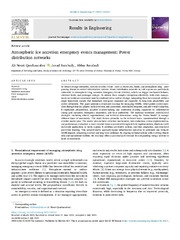| dc.description.abstract | As climate change intensifies, extreme weather events—such as heatwaves, floods, and atmospheric icing—pose growing threats to critical infrastructure systems. Power distribution networks in cold regions are particularly vulnerable to Atmospheric Icing Accretion Emergency Events (AIAEEs), which can trigger mechanical failures, electrical faults, and prolonged outages. To address these complex disruptions effectively, both crisis management and resilience assessment must be combined into a unified strategy. Integrating these two concepts within a single framework ensures that immediate emergency responses are supported by long-term adaptability and system robustness. This paper presents a structured roadmap for managing AIAEEs, which guides system operators through four key phases: early detection, risk assessment, coordinated response, and post-event evaluation. It emphasizes preparedness, adaptive decision-making, and continuous learning, supported by collaboration among grid operators, emergency responders, and local authorities. The roadmap introduces multi-layered strategies—including ethical, organizational, and technical dimensions—using the “Onion Model” to manage different types of uncertainty. This study focuses primarily on the technical layer, operationalized through a detailed master plan. The master plan includes detection mechanisms, risk evaluation, action implementation, and performance evaluation. A more detailed vision is provided through its field implementation, illustrated with real-world applications in Arctic regions. It combines preventive actions, real-time adaptation, and structured post-event learning. This comprehensive approach equips infrastructure operators to anticipate and mitigate AIAEE impacts, enhancing recovery and long-term resilience. By aligning technical actions with evolving climate risks and operational realities, the roadmap offers a practical path forward for safeguarding energy systems in harsh environments. | en_US |


 English
English norsk
norsk
